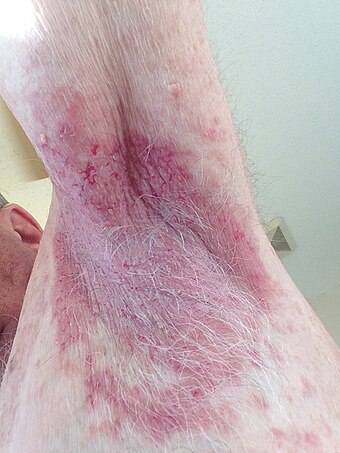Medicine:Hailey–Hailey disease
| Hailey–Hailey disease | |
|---|---|
| Other names | Familial benign chronic pemphigus |
 | |
| Left axilla mild, uninfected Hailey–Hailey lesion | |
| Symptoms | Rashes and blisters on the skin, could be painful to the touch with a possibility of acantholysis, erythema and hyperkeratosis. |
| Usual onset | Late teenage years or 30s-40s |
| Duration | Chronic |
| Causes | Mutations in the ATP2C1 gene |
| Risk factors | Family history |
Hailey–Hailey disease (HHD), or familial benign chronic pemphigus[1]:559 or familial benign pemphigus,[2]:622 was originally described by the Hailey brothers (Hugh Edward and William Howard) in 1939.[3][4] It is a genetic disorder that causes blisters to form on the skin.
Signs and symptoms
HHD is characterized by outbreaks of rashes and blisters on the skin. Affected areas of skin undergo repeated blistering and inflammation, and may be painful to the touch. Areas where the skin folds, as well as the armpits, groin, neck, buttocks and under the breasts are most commonly affected. In addition to blistering, other symptoms which accompany HHD include acantholysis, erythema and hyperkeratosis.[5] It typically begins in late teenage years or in a person's 30s or 40s. [6]
Causes
The cause of the disease is a haploinsufficiency of the enzyme ATP2C1;[7] the ATP2C1 gene is located on chromosome 3, which encodes the protein hSPCA1. A mutation on one copy of the gene causes only half of this necessary protein to be made and the cells of the skin do not adhere together properly due to malformation of intercellular desmosomes, causing acantholysis, blisters and rashes. There is no known cure.[citation needed]
Diagnosis
Classification
While the term pemphigus typically refers to "a rare group of blistering autoimmune diseases" affecting "the skin and mucous membranes",[8] Hailey–Hailey disease is not an autoimmune disorder and there are no autoantibodies.[9] According to Pemphigus Pemphigoid Foundation (IPPF), "familial benign chronic pemphigus, or Hailey–Hailey disease, is a different condition from Pemphigus".[10]
Differential diagnosis
The differential diagnosis includes intertrigo, candidiasis, frictional or contact dermatitis, and inverse psoriasis.[11] A biopsy and/or family history can confirm.[12] The lack of oral lesions and intercellular antibodies distinguishes familial benign pemphigus from other forms of pemphigus.[citation needed]
Treatment
Topical steroid preparations often help outbreaks; use of the weakest corticosteroid that is effective is recommended to help prevent thinning of the skin. Drugs such as antibiotics, antifungals, corticosteroids, dapsone, methotrexate, thalidomide, etretinate, cyclosporine and, most recently, intramuscular alefacept may control the disease but are ineffective for severe chronic or relapsing forms of the disease. Intracutaneous injections of botulinum toxin to inhibit perspiration may be of benefit.[13] Maintaining a healthy weight, avoiding heat and friction of affected areas, and keeping the area clean and dry may help prevent flares.[citation needed]
Some have found relief in laser resurfacing that burns off the top layer of the epidermis, allowing healthy non-affected skin to regrow in its place.[citation needed] Secondary bacterial, fungal and/or viral infections are common and may exacerbate an outbreak. Some have found that outbreaks are triggered by certain foods, hormone cycles and stress.
In many cases naltrexone, taken daily in low doses, appears to help.[14][15]
See also
- List of cutaneous conditions
References
- ↑ Andrews' Diseases of the Skin: Clinical Dermatology. (10th ed.). Philadelphia: Saunders Elsevier. 2006. ISBN 978-0-7216-2921-6.
- ↑ Fitzpatrick's Dermatology in General Medicine (6th ed.). New York: McGraw-Hill, Medical Pub. Division. 2003. ISBN 978-0-07-138076-8.
- ↑ Gougerot–Hailey–Hailey disease at Who Named It?
- ↑ "Familial benign chronic pemphigus.". Archives of Dermatology and Syphilology 39 (4): 679–685. April 1939. doi:10.1001/archderm.1939.01480220064005.
- ↑ "Hailey–Hailey disease". Genetic and Rare Diseases Information Center (GARD) – an NCATS Program. National Institutes of Health, U.S. Department of Health and Human Services. https://rarediseases.info.nih.gov/diseases/6559/hailey-hailey-disease.
- ↑ Konstantinou, Maria P.; Krasagakis, Konstantinos (2023), "Benign Familial Pemphigus (Hailey–Hailey Disease)", StatPearls (Treasure Island (FL): StatPearls Publishing), PMID 36256785, http://www.ncbi.nlm.nih.gov/books/NBK585136/, retrieved 2023-11-07
- ↑ "Mutations in ATP2C1, encoding a calcium pump, cause Hailey–Hailey disease". Nature Genetics 24 (1): 61–65. January 2000. doi:10.1038/71701. PMID 10615129.
- ↑ "Blistering disorders: diagnosis and treatment". Dermatologic Therapy 16 (3): 214–223. September 2003. doi:10.1046/j.1529-8019.2003.01631.x. PMID 14510878.
- ↑ "Hailey–Hailey Disease". http://rarediseases.org/rare-diseases/hailey-hailey-disease/.
- ↑ "Pemphigus". 2014-03-19. http://www.pemphigus.org/research/clinically-speaking/pemphigus/.
- ↑ Foundation, British Skin. "Hailey–Hailey disease – British Skin Foundation" (in en-GB). https://knowyourskin.britishskinfoundation.org.uk/condition/hailey-hailey-disease/.
- ↑ Ni (1), Gilbert (2), Manalo (3), Wu (4), Jonathan (1), Kathleen (2), Ivie (3), Jashin (4) (November 29, 2017). "Psoriasiform Hailey–Hailey Disease Presenting as Erythematous Psoriasiform Plaques Throughout the Body: A Case Report". The Permanente Journal 22: 17–016. doi:10.7812/TPP/17-016. PMID 29236657.
- ↑ "Familial benign pemphigus". Consultant 48 (12). November 2008. https://www.consultant360.com/content/familial-benign-pemphigus.
- ↑ "Low-Dose Naltrexone Treatment of Familial Benign Pemphigus (Hailey–Hailey Disease)". JAMA Dermatology 153 (10): 1015–1017. October 2017. doi:10.1001/jamadermatol.2017.2445. PMID 28768314.
- ↑ "Treatment of Hailey–Hailey Disease With Low-Dose Naltrexone". JAMA Dermatology 153 (10): 1018–1020. October 2017. doi:10.1001/jamadermatol.2017.2446. PMID 28768313.
External links
| Classification | |
|---|---|
| External resources |
 |


